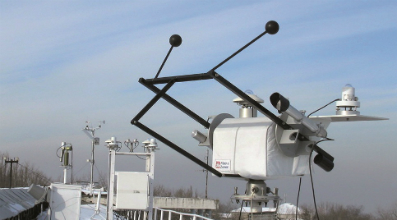“All radiometric and ozone data acquired at the monitoring station are freely accessible to research centers and universities worldwide.” says Dr. Alexander A. Aculinin, a senior scientist with the Atmospheric Research Group (ARG) at the Institute of Applied Physics of the Academy of Sciences of Moldova.
The ARG team is carrying out monitoring of solar radiation, aerosol optical properties and total ozone content (TOC) at the ground-based station located at the IAP in Kishinev, Moldova. The station was completed in 2003 and is situated in an urban part of Kishinev City. It was equipped using financial grants from the Civilian Research and Development Foundation (CRDF Global, USA) and the Moldovan Research and Development Association (MRDA) and under support from the AERONET project, NASA/GSFC.
 The station has state-of-the-art instrumentation that consists of three principal automatically operated units; radiometric complex, Skye Instruments MiniMet automatic weather station, and a Cimel-318 sun photometer.
The station has state-of-the-art instrumentation that consists of three principal automatically operated units; radiometric complex, Skye Instruments MiniMet automatic weather station, and a Cimel-318 sun photometer.
The radiometric complex is a key element of the whole station and it consists of the set of nine broadband radiometric sensors from Kipp & Zonen. The sensors are connected to the “brain” of the station - to the datalogger CR10X SM 4M running under remote control from PCs. Continuous measurements of direct, diffuse and total solar radiation are fulfilled within the wavelength range from UV to IR with broadband sensors such as CM 11 pyranometers, CH 1 pyrheliometer, and SP Lite, PAR Lite, UV-B and UV-A sensors. These sensors are mounted at the stationary (for total radiation) and rotating (for direct and diffuse radiation) platforms.
The monitoring station has been in operation since 2003 and is registered as a regional fixed station by the World Meteorological Organization (WMO). It is installed on the roof of the Institute of Applied Physics and is equipped with state-of-the-art radiometric instrumentation, an automatic weather station and an ozonometer.
“Since the measurement program started we have the opportunity to carry out complex researches, such as interconnection between solar radiation and optical properties of atmospheric aerosols, long-term variability of these parameters and total column ozone content, to use these measurements to validate satellite observations. We’ve chosen Kipp & Zonen simply because it’s very reliable, of course, if it is used reasonably and efficiently.”
Data centers with which the team is cooperating include the World Ozone and Ultraviolet Radiation Data Center (WOUDC) and the World Radiation Data Center (WRDC).